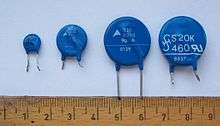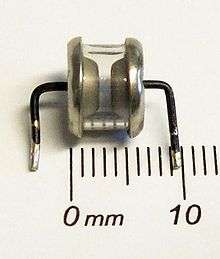Transient voltage suppressor

A transient voltage suppressor or TVS is a general classification of an array of devices that are designed to react to sudden or momentary overvoltage conditions. One such common device used for this purpose is known as the transient voltage suppression diode that is simply a Zener diode designed to protect electronics device against overvoltages. Another design alternative applies a family of products that are known as metal-oxide varistors (MOV) that protect electronic circuits and electrical equipment.[1]
The characteristic of a TVS requires that it respond to overvoltages faster than other common overvoltage protection components such as varistors or gas discharge tubes. This makes TVS devices or components useful for protection against very fast and often damaging voltage spikes. These fast overvoltage spikes are present on all distribution networks and can be caused by either internal or external events, such as lightning or motor arcing.[2]
Applications of transient voltage suppression diodes are used for unidirectional or bidirectional electrostatic discharge protection of transmission or data lines in electronic circuits. MOV-based TVSs are used to protect home electronics, distribution systems and may accommodate industrial level power distribution disturbances saving downtime and damage to equipment. The level of energy in a transient overvoltage can be equated to energy measured in joules or related to electric current when devices are rated for various applications. These bursts of overvoltage can be measured with specialized electronic meters that can show power disturbances of thousands of volts amplitude that last for a few microseconds or less.
Great care should be taken while designing overvoltage protection unit of electronic devices, because e.g. MOV was documented to have frequently caused fires while being exposed to overvoltage enough to activate MOV to start conducting, but not enough to totally destroy it, or to blow a house fuse. That condition caused significant heating of the MOV, which in turn caused printed circuit board (PCB) and MOV burning and eventually started a fire.[3][4]
Comparison of transient suppressors
| Type | Surge capability (typical) | Lifetime - number of surges | Response time | Shunt capacitance | Leakage current (approximate) |
|---|---|---|---|---|---|
| TVS-diode | 1 A (small surface-mount device) to 15 kA (large through-hole device) | ? | ≈ 1 ps (limited by pin lengths) | < 1 pF (small surface-mount device) to > 10 nF (large through-hole device) | 1 µA |
| Metal-oxide varistor (MOV) | Up to 70 kA | @ 100 A, 8x20 µs pulse shape: 1,000 surges | ≈ 1 ns | Typically 100–1,000 pF +++ | 10 µA |
| Avalanche diode, Zener diode | 50 A | @ 50 A, 8x20 µs pulse shape: infinite | < 1 µs | 50 pF | 10 µA |
| Gas discharge tube | > 20 kA | @ 20 kA, 8x20 µs pulse width: > 20 surges | < 5 µs | < 1 pF | < 1 nA |
See also
References
- ↑ "What is a Silicon Transient Voltage Suppressor ... - element14". element-14.com. Retrieved 23 September 2015.
- ↑ "Transient Voltage Suppressors (TVS) for Automot... - element14". element-14.com. Retrieved 23 September 2015.
- ↑ "metal oxide varistors - Circuit Breakers Blog - Expert Safety and Usage Information". circuitbreakersblog.com. Retrieved 23 September 2015.
- ↑ esdjournal.com
External links
| Wikimedia Commons has media related to Transient voltage suppressors. |

